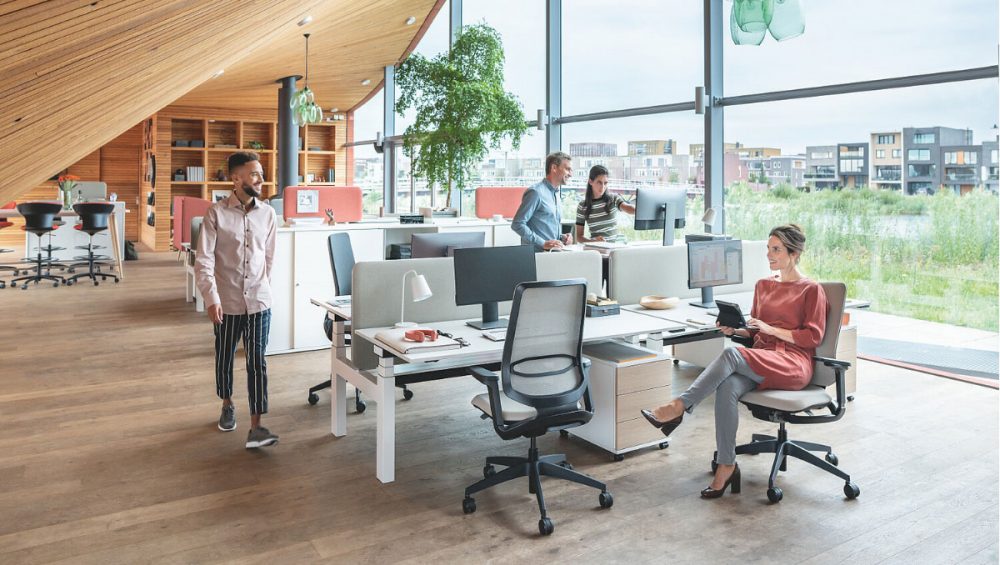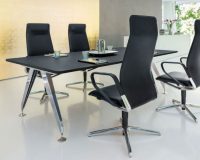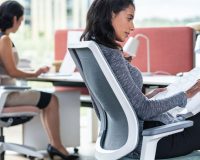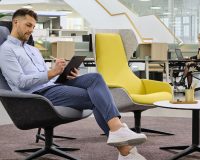The following is taken from an interview with Dr Dieter Breithecker, Director of the Bundesarbeitsgemeinschaft für Haltungs-und Bewegungsförderung e.V. (German Federal Association for the Promotion of Posture and Movement)
More and more people are spending an increasing amount of time sitting. Computer work and meetings are now cornerstones of everyday office work, and the increasingly digital nature of modern working environments will only further this trend. But these behaviours go against our innate physiology. In this interview with Dieter Breithecker we discover why his advice – ‘sit as much as necessary, move as much as possible’ – is so critical to our overall well-being, our physical and mental health, and why employers and employees alike must take responsibility for the necessary changes in office culture.
Sitting has been denounced as a health risk in recent years, even described as ‘the new smoking’. What is the current thinking?
It’s clear that the rise of the knowledge and information society, computerisation, and digitalisation have together gradually transformed people’s living environments and the way we use our bodies. We are moving less and less, and sitting more and more. According to the German Federal Statistical Office, almost half of the approximately 41 million employed people in Germany perform the majority of their work sitting at a computer. People sit for up to ten hours every day. This behaviour goes hand in hand with burning insufficient calories due to a lack of physical activity. Combine this with our equally hotly discussed modern dietary habits, and there are complex consequences for human health. Statements such as ‘sitting is the new smoking’ reflect the consistent results from the latest meta-analyses among the general population. These identify a correlation between ‘sedentary behaviour’ and the risk of cardiovascular disease, metabolic disorders (diabetes II, obesity, high blood pressure), neurocognitive diseases (including dementia), cancer, and general mortality.
It’s therefore only logical to promote more sport and exercise. Nevertheless, a report by German health insurance provider DKV (2018) determined that Germany is a country of ‘couch potatoes’. Two thirds of the population do not meet the minimum 2.5 hours of moderate activity per week as recommended by the WHO. It is also something of a fallacy to think that we can make up for multiple hours of sitting at a desk with a bit of sport and fitness in our leisure time. Exercising in our free time just can’t sufficiently compensate for hours on end spent sitting in an office without interruption. Just four hours on a chair without getting up is enough to disturb our entire metabolism.
The media may have successfully raised awareness of the issue and forced us to recognise the need to move and exercise more in our daily lives, but what are the real key issues here, and what can we do as individuals?
We just have to look at the way we’ve evolved. If we want to find solutions, we need to reflect on the past – on human history. Humanity would never have survived by just sitting still. The latest intervention studies indicate that both a drastic reduction in and regular interruption to our ‘sedentary behaviour’ (i.e. breaks every 20 to 30 minutes) lead to positive metabolic outcomes in terms of sugar and fat metabolism, insulin sensitivity, and more. Experts demand a rethink on the part of employers and employees alike. At least two hours’ screen time per day, ideally four, should be spent standing and moving around the workspace rather than sitting. Even light and moderate physical activity can stimulate positive biochemical processes beneficial to our physical and mental health – provided these are regular and integrated into our everyday working life. But this demands a change in office culture – with new ways and modes of working. Movement and exercise should no longer occur as a counterbalance, exclusively outside the confines of work – but movement, exercise and work should seamlessly merge into one. The world of work will need to adapt to more consistently accommodate movement in the workplace as a form of spontaneous, natural exercise that our bodies need. This is where the greatest untapped potential to increase our quality of life really lies – enabling us to really bring our best to our work.
That’s why there’s only really one solution: getting up and out of our chairs! This free recipe for better health and productivity boils down to regular changes in posture and proactive management on an individual level to develop a more active way of working and lifestyle. All this takes is a little organisational planning. For example, we should stand when making calls, or walk around a little. This particularly helps us to think clearly. Meetings and other talks shouldn’t be held sitting down, but around standing tables, while shorter meetings can be carried out while walking (walk and talk), preferably outdoors. Every step is a mini-workout. Daily routines need to be planned to incorporate lots of little trips – achievable, for example, by moving printers, photocopiers, and waste-paper baskets to less central locations. People should avoid sending emails to colleagues, and instead go and speak to them in person. A walk over lunch refreshes the mind and body for a productive afternoon.
Does that mean it wouldn’t really matter what you’re sitting on, if you’re getting up and moving around a lot?
I would like to explore this question with a specific example. If you’re a walking enthusiast and go on a five-hour walk, it really won’t matter to you if you spend your short 15-minute break sitting on the floor or a hard wooden bench. But if it’s the other way around, and you spend five hours sitting on that bench and only walk for 15 minutes, you’ll develop serious problems. The basic idea is that the less time children, adolescents, and adults spend sitting and the more time they spend moving around and exercising, the better their health and overall well-being. But in spite of all the best intentions, such as flexible desks that can be raised to a standing position, modern working conditions still demand that people spend a lot of time – often more than seven hours a day – sitting at a desk. If this is the case, then people should be sitting on chairs that meet the individual requirements of living and breathing human beings – and not just made for their body shape or following whatever orthopaedic or biomechanical dogmas are current at the time. Seating furniture needs to support the complex spectrum of behaviours an employee embodies – in mind, body, and spirit – and it must be able to adapt to different functional needs (sitting posture) as required.
You are calling for office swivel chairs that allow ‘active’ sitting. What’s the difference between this and ‘dynamic’ sitting, a term already often used in industry advertising?
There are certain slogans that take on a life of their own without ever really being questioned. ‘Dynamic’ sitting is one of these terms. Not all movement or exercise is equal. If we look closer, we can see the only real movement offered by most of these chairs is around the hip joints. But that doesn’t do justice to the human body’s needs as an active physical, intellectual, and emotional system. As Leonardo da Vinci once stated, ‘Life is movement’. This is in our genes, and that’s the framework on which our complex physiology is based. Sitting still is not a biological state. Taking this view to an extreme, it can be seen as akin to death.
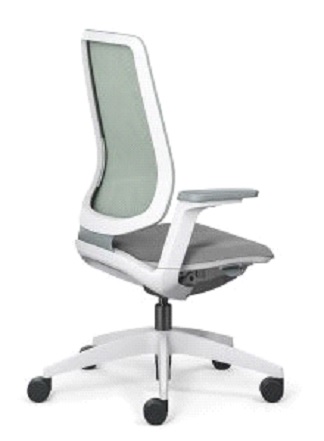
Active sitting therefore goes beyond the recommendations around dynamic sitting, as you’ll find advertised in the context of synchronous mechanisms or planned regular changes in the user’s sitting position. Active sitting can’t really be recommended or taught. Active sitting is more something that needs to develop spontaneously in its natural complexity in response to physical, mental, and even psychological needs. The pivotal point for this is a seating area that allows multi-dimensional movement, moving away from synchronous mechanisms, with progressive cushioning – often described as three-dimensional (3D) seating. This results in the complex interaction of the pelvis, legs, spine, shoulders, and head as a functional unit. Just like when standing, sitting on this kind of chair involves complex and spontaneous micro- and macro-movements (positional changes), adapting your position to your needs. It’s just that we are usually not aware of these. The human desire to achieve physical and mental well-being is shaped by the way we have developed over time. Until a few thousand years ago, humans alternated between crouching, kneeling, lying down, standing, and walking or running an average of more than 15 km per day. We would rarely sit for long periods of time. And our physiological requirements to carry out these behaviours to maintain our physical, mental, and emotional well-being have remained unchanged to this day. Goethe once remarked that sitting comfortably gets in the way of productive thinking.
Does this mean that active sitting is something that happens automatically, as in, without our knowledge, when we use a chair with the right functionality?
The human organism is a complex system in which unstable forces are held in equilibrium by metabolic reactions. This gives the organism a wide range of ways to autonomously – unconsciously – and speedily adapt to fluctuating conditions and requirements. Thus, the human body is able to respond to discomfort as it needs to and of its own accord. This means that we possess the ability to autonomously compensate, adapt, control and regulate our behaviour to avoid dysfunction. We owe this ability to our evolution and to the developmentally ‘older’ parts of the brain that regulate our primary, critical bodily processes. These processes bypass the neocortex, a developmentally ‘younger’ area of the brain where higher thought processes such as structured problem solving occur. This is the only way that we are able to react quickly and appropriately to our bodies’ signals of stress before we have consciously realised what is actually going on. This ability manifests itself in a highly irregular way, since this well-adjusted complex system becomes active upon receiving a signal that there is a physical, mental, or emotional need. The effect is most obvious in a person standing unsupported. They will shift their weight between the free and weight-bearing leg irregularly and unconsciously, and shift on their axis – all completely automatically. And an emotionally engaged and mentally focused speaker will rarely be able to impress their audience without being animated in some way. Our mental, physical, and emotional lives always involve movement and should not be constricted to a static posture.
Following that through, is there no right or ideal way to sit?

Based on known paradigms for healthy people, there is no ‘correct’ or ‘ideal’ way to sit. Just like there’s not a ‘correct’ or ‘ideal’ way to stand or breathe. In exceptional cases, such as postoperative aftercare, there may be certain restrictions in movement. But a healthy organism has sufficient inborn physiological intelligence that, given appropriate conditions, it is capable of performing all natural functions in a highly automatic way to meet its own needs. One example of this is the cardiovascular and respiratory system, which can intricately adapt to different requirements. A chair with a three-dimensional seat that moves freely, unbound by any synchronous mechanism, supports an ‘ideal’ way of sitting in much the same way. Here, too, a flexible seated posture can develop and freely adapt without any conscious control, just like when we stand unsupported. This autonomous sensory and neuromuscular posture control in turn triggers complex biochemical and therefore also psychological and mental mechanisms. In recent years, modern imaging techniques have allowed scientists to verify how interwoven and interactive physical, psychological and mental processes are. ‘Move the body and your spirit will follow.’ Physical movement – beyond just intentional exercise – stimulates metabolic processes in the brain and body, boosting both physical and mental vitality. The science is clear on this. Movement and exercise are good for more than physical health alone. They are also critical for boosting learning and productivity, help to keep depression at bay, and generally help to unlock human potential.
What can employers do and where do employees also share responsibility?
Every employee in a company is an important resource. Boosting the physical and mental capacity of the employee and allowing their potential to unfold – even during working hours – should be a key pillar of every corporate philosophy. This is why discussions on workspace concepts based around employees’ biological, psychological, social, and human needs are helpful in every company. Experts always refer back to the interaction between people and space. Winston Churchill once said, ‘We shape architecture, thereafter it shapes us.’ A person’s work environment, like architecture, is the space in which they live for at least eight hours a day. Under ideal conditions, it is a space of comfort, a space which promotes their personal health, a space which facilitates social exchange, and therefore also psychological development and productive work. We call for room designs that support and actively promote movement (daylight, acoustics, and so on set aside for a moment). In concrete terms, this means that to satisfy an individual’s need to live in tune with their own rhythm – the natural alternation between tension and relaxation, exertion and recovery – and thus promote their own well-being – work environments must also offer flexible ‘zones’, each with their own hidden ‘temptations’, that satisfy biological, psychological and social needs, alongside work-related requirements. For example, open or closed rooms designed for not just team and group work, but also individual work. There also needs to be space for solitary retreat and relaxation, and both the discreet and open exchange of information. And spaces dedicated to physical activity or relaxed play should certainly not be taboo. These defined rooms give employees the additional assurance that their needs, such as a short nap to relax, are socially accepted.
At the same time, this also requires that competence is transferred to the employee (in terms of self-competence and training). They must take responsibility for themselves. They need to become co-decision-makers, invested in the idea of achieving a positive change in lifestyle, including in their free time. A change of attitude is required both at management level and among employees. Each employee absolutely must become a co-decision maker (a designer or self-expert) to develop individual and needs-based behaviours that will serve them well in the long term. They must be involved in the process of inhabiting a healthy workspace and shaping the habits of their everyday life (an intervention of sorts). This prevents people from blindly following silly ideas or strictly linear procedures. It ensures a high level of ‘compliance’, or better: ‘empowerment’. Employees need to become co-decision-makers – and that demands a capacity to take action and responsibility for their health and well-being.

